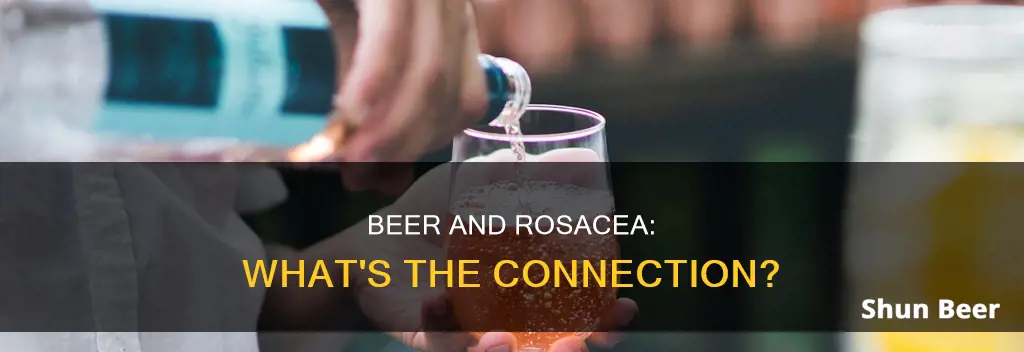
Drinking alcohol is a common trigger for rosacea, a chronic inflammatory skin condition that causes redness on the cheeks, chin, forehead, and nose. While alcohol doesn't cause rosacea, it can worsen the condition and increase the risk of developing it. Research suggests that drinking alcohol increases the production of inflammatory cytokines, causing blood vessels to widen and exacerbating rosacea. However, it's important to note that not everyone with rosacea reacts the same way to alcohol, and some people may be able to tolerate certain types of alcoholic beverages better than others. Beer, for example, has been found to have anti-inflammatory properties due to the presence of hops, which may help reduce redness associated with rosacea.
| Characteristics | Values |
|---|---|
| Alcohol's effect on rosacea | Alcohol is a vasodilator, which causes blood vessels to dilate and can trigger rosacea flare-ups. |
| Alcohol's role in causing rosacea | Research suggests that drinking alcohol may increase a person's risk of getting rosacea. |
| Rosacea triggers | Triggers for rosacea include exposure to sunlight, stress, heat, spicy foods, and alcohol. |
| Alcohol types and rosacea | Red wine is the most common trigger for rosacea flare-ups, followed by white wine, beer, and liquor. |
| Managing rosacea and alcohol | People with rosacea can try drinking slowly, opting for chilled drinks, alternating alcoholic drinks with water, and avoiding known triggers. |
What You'll Learn

Alcohol intake increases the risk of developing rosacea
The link between alcohol and rosacea can be explained by the fact that alcohol causes blood vessels to dilate, exacerbating the condition. Alcohol is a vasodilator, which leads to flushed skin for most people after a few drinks. This is why people with rosacea may feel embarrassed by their red faces, as others may assume they are heavy drinkers. However, it is important to note that people who do not drink alcohol can also develop rosacea, and alcoholism does not cause rosacea.
Among different types of alcoholic beverages, wine, especially red wine, has been found to be the worst trigger for rosacea flare-ups. A survey by the National Rosacea Society found that 76% of respondents cited red wine as the worst trigger, while 56% said that white wine brought on an outbreak. Skin reactions from beer were reported by 41% of respondents, while 33% said champagne and vodka were equally aggressive triggers.
While there is no one-size-fits-all approach to drinking with rosacea, as everyone's triggers vary, there are some general tips that may help minimize the risk of a flare-up. These include opting for chilled alcoholic drinks, drinking slowly, alternating alcoholic drinks with water, and avoiding other known triggers such as spicy foods and hot beverages. Additionally, keeping a diary to track flares and determine individual triggers can be helpful.
It is also worth noting that certain compounds in beer have shown anti-inflammatory properties, which may reduce redness when consumed before other alcoholic drinks. However, more research is needed to understand the role of these compounds in treating skin conditions like rosacea.
Beer Batters: How Do They Work?
You may want to see also

Alcohol dilates blood vessels, leading to redness
Alcohol's impact on the circulatory system is twofold. At low levels of consumption, alcohol acts as a vasodilator, causing blood vessels to relax and expand. This can slightly benefit the heart and blood vessels by reducing the amount of work the heart has to do. However, at high levels of consumption, alcohol acts as a vasoconstrictor, causing veins to tighten and constrict. Both of these conditions can negatively affect blood pressure.
The impact of alcohol on blood vessels is particularly relevant to individuals with rosacea, a chronic inflammatory skin condition that causes redness on the cheeks, chin, forehead, and nose. Rosacea affects more than 16 million Americans, and drinking alcohol is a common trigger for flares.
The link between alcohol and rosacea lies in the fact that alcohol causes blood vessels to dilate. When evaluating rosacea risk in American women, researchers found that drinking alcohol increased the production of inflammatory cytokines that cause blood vessels to widen. This widening of blood vessels is believed to exacerbate rosacea symptoms.
The amount of alcohol it takes to trigger rosacea varies from person to person, as each individual has a different tolerance. However, research suggests that drinking alcohol may increase a person's risk of developing rosacea. A study published in the Journal of the American Academy of Dermatology found that the risk of developing rosacea increased with the amount of alcohol consumed, with women who drank white wine or hard liquor having a greater risk compared to those who drank other types of alcohol.
While the impact of alcohol on rosacea is well-documented, it is important to note that not all individuals with rosacea will experience flares triggered by alcohol. Additionally, the specific type of alcoholic beverage and other factors such as temperature can also play a role in triggering flares. For example, chilled white wine may be less likely to cause a flare than room temperature red wine.
Hydrometer Basics: Crafting Beer Perfection
You may want to see also

Red wine is the most common trigger for rosacea
Rosacea is a skin condition that causes redness on the cheeks, chin, forehead, and nose. It affects over 16 million Americans, and facial redness can be triggered by various factors, including sun exposure, stress, exercise, spicy foods, and alcohol. While drinking alcohol may not be a direct cause of rosacea, research suggests that it can increase the risk of developing the condition.
According to a survey by the National Rosacea Society (NRS), alcohol is a trigger for nearly 76% of respondents with rosacea. Among alcoholic beverages, red wine is the most likely to trigger a flare-up, with 72% of respondents citing it as a cause. This is followed by white wine (49%) and beer (42%). The survey also found that it doesn't take a large amount of alcohol to trigger a flare-up, with 31% of respondents saying that one drink is enough, and 15% saying that even a sip or two is sufficient.
The link between rosacea and alcohol consumption has been explored in several studies. One study published in the Journal of the American Academy of Dermatology found that women who drank alcohol had a higher risk of developing rosacea than those who didn't. Additionally, the risk increased with the amount of alcohol consumed. Another study evaluating rosacea risk in American women found that drinking alcohol increased the production of inflammatory cytokines, causing blood vessels to widen, which exacerbates rosacea symptoms.
While the specific reasons for red wine being the most common trigger are not clear, it is known that alcohol is a vasodilator, causing blood vessels to dilate and leading to flushed skin. This effect is likely more pronounced with red wine due to its higher alcohol content compared to other beverages. Additionally, alcohol raises the body temperature, which can further trigger rosacea flares, especially when combined with other factors such as stress and extreme weather conditions.
To minimize the risk of rosacea flare-ups, individuals with this condition can consider opting for chilled white wine or other alcoholic drinks that are less likely to irritate their skin. Keeping track of personal triggers and drinking slowly can also help manage the condition.
The Beer Hall Putsch: What If It Succeeded?
You may want to see also

Beer has anti-inflammatory properties but can still trigger rosacea
While it's not recommended to drink beer or any alcohol if you have rosacea, some people with the condition find they can tolerate particular kinds of alcoholic drinks. Beer, for instance, has anti-inflammatory properties that may help to reduce redness. However, it's important to note that everyone's triggers are different, and beer can still trigger rosacea for some people.
Rosacea is a chronic inflammatory skin condition that affects over 16 million Americans. It causes redness on the cheeks, chin, forehead, and nose, and can be triggered by various factors, including sun exposure, stress, exercise, spicy foods, and alcohol. While a single cause of rosacea has not been identified, the triggers are increasingly understood, and alcohol is known to be a common one.
A study published in the Journal of the American Academy of Dermatology found that women who drank alcohol had a higher risk of developing rosacea than those who didn't. The risk increased with the amount of alcohol consumed, and women who drank white wine or hard liquor had a greater risk than those who drank beer or other types of alcohol.
However, it's important to note that not everyone who drinks alcohol will develop rosacea, and some people with rosacea do not drink alcohol at all. Alcoholism does not cause rosacea, and having a red face does not mean someone has a drinking problem.
So, what's the connection between rosacea and alcohol? Alcohol causes blood vessels to dilate, which can exacerbate rosacea. Additionally, alcohol raises the body temperature, which can trigger a flare-up. However, beer may have some benefits for people with rosacea due to its anti-inflammatory properties.
According to one source, the hops in beer act as an anti-inflammatory. This may help to reduce the redness associated with rosacea. However, research on the effects of beer on skin diseases is limited, and more studies are needed to understand the role of beer in treating skin conditions like rosacea.
In conclusion, while beer has anti-inflammatory properties that may help reduce redness in people with rosacea, it can still trigger flare-ups for some individuals. The best way to manage rosacea is to identify your individual triggers and avoid them as much as possible. If you choose to drink alcohol, it's important to drink in moderation and pay attention to your body's reactions. Additionally, drinking slowly, opting for chilled drinks, and alternating alcoholic drinks with water can help to minimize the risk of a rosacea flare-up.
Beer and Hyoscyamine: A Safe Mix?
You may want to see also

Rosacea flare-ups can be managed by drinking slowly and alternating with water
Drinking alcohol is a common trigger for rosacea flare-ups, and it's important to know your individual triggers. However, there are ways to manage rosacea flare-ups if you want to enjoy a drink. Firstly, drinking slowly can help to reduce your cumulative alcohol intake, which in turn can lower the chances of a flare-up.
Another way to manage rosacea flare-ups is to alternate alcoholic drinks with a glass of water. Alcohol is a diuretic, which means it promotes urination and can lead to dehydration. Dehydration can cause skin sensitivity and compromise the skin's barrier, making it more prone to flaring. Drinking water helps to dilute the alcohol in your system and prevent pH changes, which can also reduce the risk of a flare-up.
In addition to drinking slowly and alternating with water, opting for chilled drinks over room-temperature drinks can be beneficial. Heat is a vasodilator, causing blood vessel expansion and increasing the likelihood of a flare-up. Chilled beverages can help to minimise blood vessel expansion.
While beer is a trigger for some people with rosacea, it may be a better option than other alcoholic drinks. Research suggests that some compounds in beer have anti-inflammatory properties, which could potentially help to reduce redness. However, more research is needed to fully understand the role of these compounds in treating rosacea.
It's worth noting that the majority of people with rosacea report that red wine is the drink that causes the most flare-ups, followed by white wine and then beer. Liquor tends to affect the smallest number of rosacea sufferers. Therefore, if you're looking to minimise the risk of a flare-up, opting for a cocktail or liquor may be a safer choice than red wine.
Finally, keeping a diary of your alcohol consumption and any subsequent flare-ups can help you identify your individual triggers and determine the amount of alcohol you can tolerate. This can empower you to make informed choices about your alcohol consumption and manage your rosacea effectively.
Beer and Optavia: What You Need to Know
You may want to see also
Frequently asked questions
Beer is not recommended for people with rosacea, but some people with the condition find that they can drink beer without triggering a flare-up.
Triggers for rosacea include alcohol, stress, sun exposure, heat, spicy foods, and certain foods.
Alcohol is a vasodilator, which means it causes blood vessels to dilate, leading to redness and inflammation in the skin.
Liquors like tequila, bourbon, gin, rum, and whiskey have been shown to trigger rosacea less often than wine or beer. Chilled drinks and drinks with ice may also be better options.







